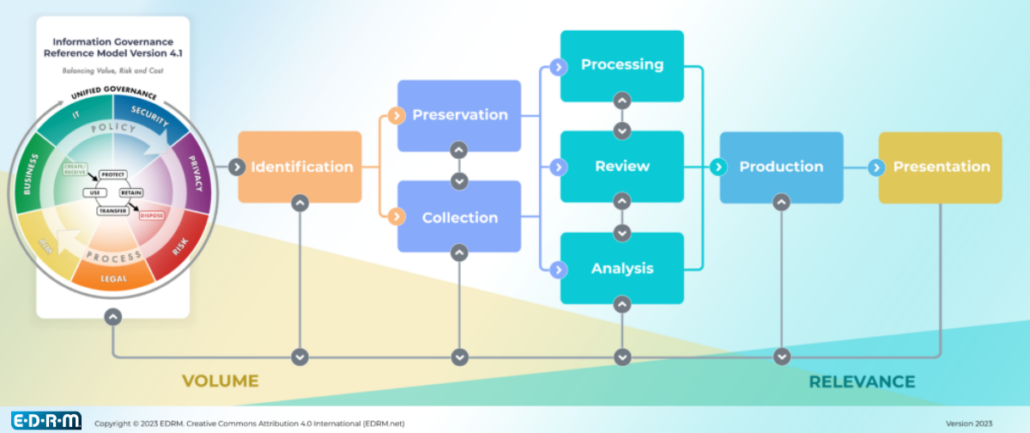Think the EDRM is just a techie buzzword?
Think Again!
If you’ve ever felt like the EDRM was just another piece of alphabet soup designed to make your brain hurt, you’re not alone. But fear not! I’m here to guide you through the labyrinth of eDiscovery like a pro. Let’s unravel this thread together and discover why the EDRM isn’t just important—it’s essential.

WTF is the EDRM?
The EDRM, or Electronic Discovery Reference Model, is like the grand blueprint for digital detectives in the legal tech world. It’s this comprehensive process that takes you from the “we might need this data” moment all the way to “all eyes in the courtroom on this piece of evidence.” In simple Technocat terms, it’s your go-to workflow for managing the madness that is eDiscovery, ensuring nothing slips through the cracks from the moment you start collecting data to the second it helps you shine in front of a judge or jury. It’s not just a model; it’s the playbook for electronic discovery success.
Think of it as your personal GPS, guiding you from the wild frontiers of data governance all the way to the promised land of presentation in court. It’s a journey every bit as epic as it sounds, and with the EDRM in your toolkit, you’ll be navigating it like a seasoned explorer.

What’s in an EDRM?
When the eDiscovery process first came around, back in the olden days of 2006 Federal Rules amendments, Legal professionals really did not even know where to begin. That is where the Godfather Himself George Socha and Tom Gelbman banded together in 2005 to map out what the heck happens during eDiscovery… the result was a handy 9 box workflow that the entirety of the eDiscovery industry has sprung up around and relied upon since the early days.
Now when Legal teams are faced with the daunting task of discovering what the heck is going on in their client’s electronically stored information (ESI)… bam we turn to the EDRM Model.
Tom and George Broke the quest to find relevant ESI in legal proceedings into 9 stages of the EDRM.
- Information Governance: This is where you lay down the law (pun intended) on your data. Govern it with an iron fist so when the time comes, you know what you have, where it is, and how to get it.
- Identification: Here’s where your inner detective shines. You’re identifying the who, what, where, and why of your data. What’s relevant, and what’s just digital fluff? Find whose data you want to look at and where it lives.
- Preservation: Now that you’ve spotted the good stuff, you need to keep it safe. Preserve it like it’s the last piece of evidence on Earth because, in this case, it just might be. Or else you may face a sanction for Spoliation!
- Collection: Time to collect that data without changing it—kind of like picking up a diamond with tweezers. You want it pristine, untouched, and in its original glam.
- Processing: You’ve got data, but you’ve also got noise. Processing is about cutting the wheat from the chaff, reducing volumes, and getting ready for the next big step. Turn 1s and 0s into a reviewable format and get rid of garbage data.
- Review: The nitty-gritty. It’s you (and maybe an army of reviewers) against the world of data, armed with your redaction pens and tagging tools, deciding what’s hot and what’s not.
- Analysis: Deep dive into the data ocean. You’re looking for patterns, trends, and the hidden story behind the bytes. It’s the ‘Aha!’ moment in the making.
- Production: After all that work, it’s time to show your cards. Producing data in the right formats, with all the necessary bells and whistles for the opposing counsel and the courts. Share the non-garbage data relevant to the matter with interested parties.
- Presentation: The grand finale. Take that curated, refined, and court-ready data and turn it into a compelling narrative that’ll have judges and juries hanging on your every word.
In practice, the eDiscovery process may be much messier. There may be many things that cause you to backtrack, repeat a step, or even start the whole darn process over. This is completely normal. Be sure to document your process throughout and work with technology designed to adapt along with you.
The EDRM and You
So, what’s the big takeaway after our deep dive into the EDRM? It’s simple: mastering this model is like having the ultimate cheat sheet for the digital age of law. It’s about getting savvy with your data before it gets the best of you, making sure you’re the puppet master, not the other way around.
Remember, the EDRM isn’t just a guideline; it’s the gospel according to eDiscovery, and it’s as dynamic as the world of legal tech itself. Keep it close, and you’ll find that navigating the complexities of digital evidence becomes less of a headache and more of a strategic edge.
As you step out and apply these principles, you’re not just going through the motions; you’re choreographing a dance with data, setting the stage for success in the courtroom and beyond. The EDRM is your script, your playbook, your battle plan. Know it, live it, and use it to bring your A-game to the legal field.


